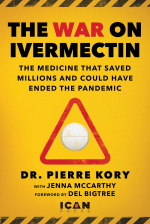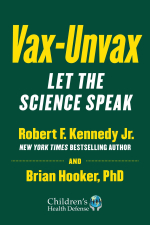Neil Z. Miller: An Association Between Childhood Vaccines and Mortality
An Association Between Childhood Vaccines and Mortality
by Neil Z. Miller
In 2011, Dr. Gary Goldman and I published a study demonstrating that among the most highly developed nations, those that require the most vaccines for their infants tend to have the worst infant mortality rates. Ten years later, Dr. Elizabeth Bailey, a professor at Brigham Young University, and several students associated with her Bioinformatics Capstone course read our study and found it “troublesome that this manuscript is in the top 5% of all research outputs.” They conducted their own study to refute our paper, and posted it on the medXriv preprint server.
[https://www.ncbi.nlm.nih.gov/pmc/articles/PMC3170075/pdf]
[https://www.medrxiv.org/content/10.1101/2021.09.03.21263082v4]
A few months later, I was contacted by the editor of a major medical journal inviting me to review a manuscript that “makes statements in contradiction to work you have previously published.” Apparently, our critics at BYU submitted their paper to this journal to have it peer-reviewed and published.
The Bailey paper contained many flaws, which were thoroughly discussed in my review. Ultimately, their manuscript was withdrawn from the journal and not published. However, the preprint containing false claims made against our paper was never removed from public accessibility. This incentivized Gary and I to defend our paper within the medical literature and further investigate potential associations between vaccines required during infancy and infant mortality rates.
Using updated 2019 data, we corroborated the significant positive correlation demonstrated in our 2011 paper. This new study was published in February of this year.
Neonatal vaccines
Many nations require hepatitis B and/or BCG (bacille Calmette-Guerin) vaccines (for tuberculosis) to be given to newborns as soon as possible following birth. In most nations, more than half of all infant deaths occur during the neonatal period (the first 28 days of life). Therefore, after our second paper was published, we decided to broaden our analyses to explore potential relationships between the number of neonatal vaccine doses required by nations and their neonatal mortality rates, infant mortality rates, and under age five mortality rates.
In our third study published July 2023, we compared the childhood mortality rates of developed nations that required their newborns to receive zero, one, or two vaccine doses. We looked at data for 2019 and 2021. Nations that required two vaccine doses (for hepatitis B and BCG) were found to have significantly higher neonatal, infant, and under age five mortality rates as compared to nations that required neither vaccine.
We also found that vaccine doses (for hepatitis B and tuberculosis) given during the neonatal period are more highly correlated with infant mortality rates (r = 0.46) and under age five mortality rates (r = 0.48) but less so with neonatal mortality rates (r = 0.34). This suggests that some deaths associated with neonatal doses may be delayed.
Premature newborns (and full-term babies with low birth weight) may be particularly susceptible to serious adverse reactions to vaccines, including life-threatening apnea. Researchers found that 12% of vaccinated preterm infants experienced apnea within 72 hours post-vaccination.
[https://www.jpeds.com/article/S0022-3476(97)80017-0/fulltext]
In a study of future SIDS victims, researchers found that apneas preceded their deaths by a median of eight weeks. According to other researchers, “the findings in a certain number of ‘near miss SIDS’ cases support the hypothesis that there might be a link between some infants with prolonged sleep apnea and some later SIDS victims.” Thus, some apneas that occur in the early neonatal period may not escalate to a complete expiration of life until the post-neonatal stage of infancy.
[https://academic.oup.com/sleep/article/15/4/287/2749268]
[https://link.springer.com/article/10.1007/BF00442298]
SIDS is the leading cause of death during the post-neonatal period. For example, infant mortality and SIDS cases reported to VAERS tend to occur around the time of vaccine administration. In one study of 1048 SIDS cases, 51% clustered within 3 days post-vaccination and 76% within 7 days post-vaccination, a statistically significant finding (p < .00001).
[https://www.sciencedirect.com/science/article/pii/S2214750021001268]
Another hypothesis is that neonatal vaccines, through some priming mechanism or cumulative toxicity may increase the risk of a severe or fatal reaction to subsequently administered vaccines.
Neonatal vaccine doses appear to have a significant impact on mortality. There was a statistically significant difference of 1.28 deaths per 1000 live births between the mean infant mortality rates among nations that did not give their neonates any vaccine doses and those that required them to receive two vaccine doses.
Infant mortality
In our 2021 analysis of the top 50 nations, the infant mortality rate increased by 0.167 deaths/1000 live births for each additional vaccine dose added to the immunization schedule. Each reduction of six vaccine doses improves the infant mortality rate by one death per 1000 live births.
When our 2019 regression analysis was limited to the top 20 nations (rather than the top 44), the correlation coefficient increased from r = 0.45 to r = 0.73 (p < .0003), revealing a strong direct relationship between the number of vaccine doses routinely administered during infancy and infant mortality rates. Similar results were found with our 2021 regression analysis.
Under age five vaccines
Neonatal and infant vaccine doses versus under age five mortality rates yield more robust positive correlations than under age five vaccine doses versus under age five mortality rates. Children in the first year of life, as compared to the second through fifth years of life, weigh less and are receiving more vaccines in a shorter time period.
Misclassification of neonatal deaths
The official list of 130 Selected Causes of Infant Death, compiled from the International Classification of Diseases (published by the World Health Organization) does not provide a medical code for vaccine-related mortality. Thus, doctors, coroners, and other medical examiners are compelled to misclassify and conceal vaccine-related fatalities under alternate cause-of-death classifications.
Our study appears to be consistent with studies by Dr. Aaby and others showing that all-cause mortality increases when a non-live vaccine is given at the same time as a live vaccine. Neonates in our study that received both BCG (live) and Hep B (non-live) vaccines as soon after birth as possible had the worst mortality.
[https://www.sciencedirect.com/science/article/abs/pii/S0264410X0601111X]
Conclusion
When developed nations require two instead of zero neonatal vaccine doses, or many versus fewer infant vaccine doses, our study suggests there may be unintended health outcomes that increase all-cause mortality. Health authorities have a responsibility to determine the full impact of their current vaccination schedules on deaths from any cause. More safety research is needed on the number of childhood vaccines given concurrently and cumulatively to confirm they are providing the intended effects on child survival.
Neil Z. Miller is a medical research journalist and Director of the Thinktwice Global Vaccine Institute. He has devoted the past 25 years to educating parents and health practitioners about vaccines, encouraging informed consent and non-mandatory laws. He is the author of several professional scientific papers and books on vaccines, including Miller’s Review of Critical Vaccine Studies (2016), Vaccine Safety Manual for Concerned Families and Health Practitioners, Make an Informed Vaccine Decision for the Health of Your Child (with Dr. Mayer Eisenstein) and Vaccines: Are They Really Safe and Effective? Past organizations that he has lectured for include the International Chiropractic Pediatric Association, the International College of Integrative Medicine, Autism One, Maximized Living, and the Culture of Life Institute. Mr. Miller has a degree in psychology and is a member of Mensa. He lives in Northern New Mexico.
### From Skyhorse Publishing
 The War on Ivermectin: The Medicine that Saved Millions and Could Have Ended the Pandemic
The War on Ivermectin: The Medicine that Saved Millions and Could Have Ended the Pandemic
#1 Seller in Forensic Medicine
By Pierre Kory Dr. (Author), Jenna McCarthy (Author)
Big Pharma and health agencies cry, “Don’t take ivermectin!” A media storm follows. Why then, does the science say the opposite?” Ivermectin is a dirty word in the media. It doesn’t work. It’s a deadly horse dewormer. Prescribe or promote it and you’ll be called a right-wing quack, be banned from social media, or lose your license to practice medicine. And yet, entire countries wiped out the virus with it, and more than ninety-five studies now show it to be unequivocally effective in preventing and treating Covid-19. If it didn’t work, why was there a coordinated global campaign to cancel it? What’s the truth about this decades-old, Nobel Prize-winning medication? The War on Ivermectin is the personal and professional narrative of Dr. Pierre Kory and his crusade to recommend a safe, inexpensive, generic medicine as the key to ending the pandemic.
 Vax-Unvax: Let the Science Speak (Children’s Health Defense) Hardcover – Illustrated, August 15, 2023 by Robert F. Kennedy Jr. (Author), Brian Hooker (Author)
Vax-Unvax: Let the Science Speak (Children’s Health Defense) Hardcover – Illustrated, August 15, 2023 by Robert F. Kennedy Jr. (Author), Brian Hooker (Author)
Based on over one hundred studies in the peer-reviewed literature that consider vaccinated versus unvaccinated populations. Each of these studies is analyzed and put in context of the difference in health outcomes of vaccinated versus unvaccinated infants, children, and adults. Given the massive push to vaccinate the entire global population, this book is timely and necessary for individuals to make informed choices for themselves and their families.
![]()
For the rest of this article please go to source link below.

